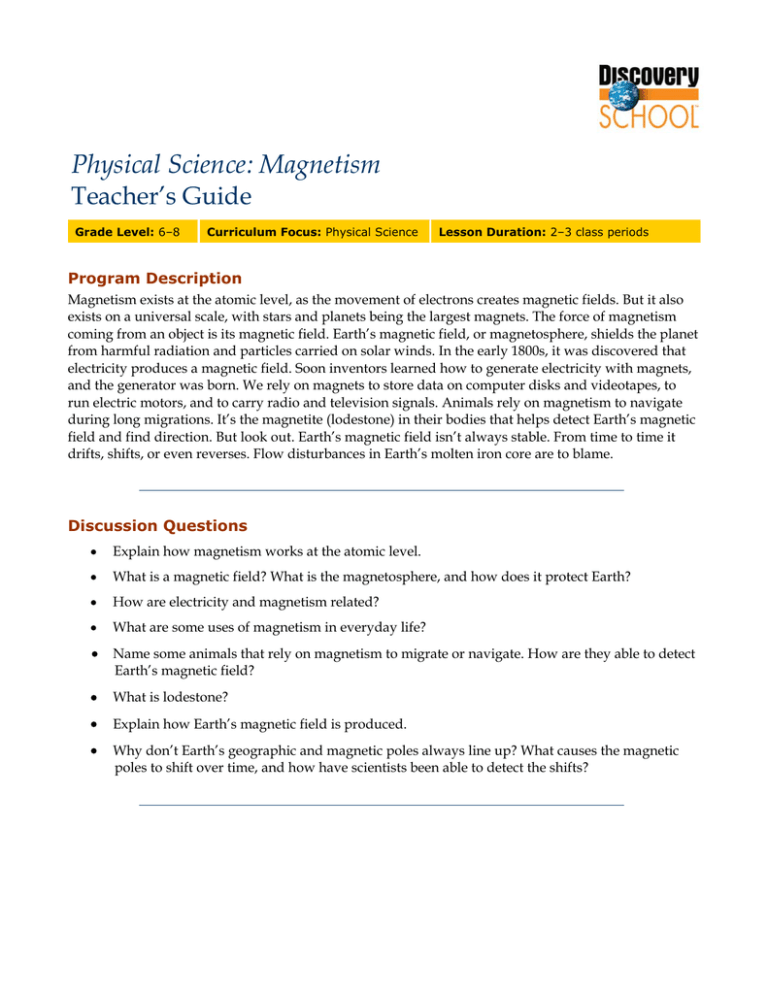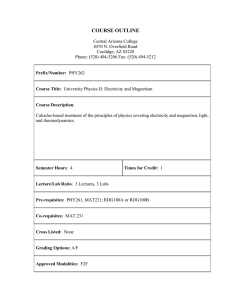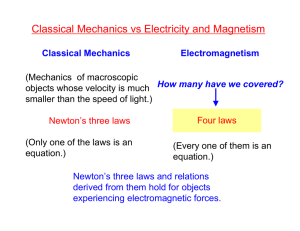
Physical Science: Magnetism
Teacher’s Guide
Grade Level: 6–8
Curriculum Focus: Physical Science
Lesson Duration: 2–3 class periods
Program Description
Magnetism exists at the atomic level, as the movement of electrons creates magnetic fields. But it also
exists on a universal scale, with stars and planets being the largest magnets. The force of magnetism
coming from an object is its magnetic field. Earth’s magnetic field, or magnetosphere, shields the planet
from harmful radiation and particles carried on solar winds. In the early 1800s, it was discovered that
electricity produces a magnetic field. Soon inventors learned how to generate electricity with magnets,
and the generator was born. We rely on magnets to store data on computer disks and videotapes, to
run electric motors, and to carry radio and television signals. Animals rely on magnetism to navigate
during long migrations. It’s the magnetite (lodestone) in their bodies that helps detect Earth’s magnetic
field and find direction. But look out. Earth’s magnetic field isn’t always stable. From time to time it
drifts, shifts, or even reverses. Flow disturbances in Earth’s molten iron core are to blame.
Discussion Questions
•
Explain how magnetism works at the atomic level.
•
What is a magnetic field? What is the magnetosphere, and how does it protect Earth?
•
How are electricity and magnetism related?
•
What are some uses of magnetism in everyday life?
• Name some animals that rely on magnetism to migrate or navigate. How are they able to detect
Earth’s magnetic field?
•
What is lodestone?
•
Explain how Earth’s magnetic field is produced.
•
Why don’t Earth’s geographic and magnetic poles always line up? What causes the magnetic
poles to shift over time, and how have scientists been able to detect the shifts?
Physical Science: Magnetism
Teacher’s Guide
2
Lesson Plan
Student Objectives
•
Be able to define magnetism.
•
Learn about uses of magnetism and how it is important to our lives.
•
Perform experiments with magnets and write a fantasy story about being able to manipulate
magnetic fields.
Materials
•
Computer with Internet access
•
Print resources about magnetism
•
Other materials specified in experiments mentioned below
Procedures
1. Review concepts of magnetism with the class. For online reviews visit the following Web sites:
•
http://en.wikipedia.org/wiki/Magnetism
•
http://www.sciencetech.technomuses.ca/english/schoolzone/Info_Magnets.cfm
•
http://science.nasa.gov/ssl/pad/sppb/edu/magnetosphere/bullets.html
•
http://micro.magnet.fsu.edu/electromag/index.html
2. Even more fun is to experiment with magnets first hand. Magnet activities abound. Here are
just some of the online sources, most using magnets and other easy-to-come-by materials:
•
Discovery School has two lesson plans featuring magnet experiments:
Curriculum Center: Magnetism
http://school.discovery.com/curriculumcenter/magnetism/
and Understanding Magnetism
http://school.discovery.com/lessonplans/programs/understandingmagnetism/index.html
•
The Exploratorium: Snacks About Magnetism
http://www.exploratorium.edu/snacks/iconmagnetism.html
•
Magnet Man: Cool Experiments with Magnets
http://my.execpc.com/~rhoadley/magindex.htm
3. A great way to wrap up your magnet studies and to emphasize the importance of magnetism in
our lives is to let students walk in the shoes of a superhero with ability to manipulate magnetic
fields. Have students write a brief essay beginning with the sentence: “If I could control
magnetism, I would … .“ In their essays, students should focus on technologies or natural
Published by Discovery Education. © 2005. All rights reserved.
Physical Science: Magnetism
Teacher’s Guide
3
phenomena they could affect with their super power. How would they use that power? What
might be the result?
4. Share the essays with the entire group.
Assessment
Use the following three-point rubric to evaluate students' work during this lesson.
•
3 points: Students were highly engaged in class discussions; successfully conducted magnet
experiments; wrote a creative, thoughtful story.
•
2 points: Students participated in class discussions; conducted magnet experiments; wrote a
good story.
•
1 point: Students participated minimally in class discussions; did not successfully conduct
magnet experiments; turned in a poorly written story.
Vocabulary
aurora
Definition: Bands of light that can be seen in the skies at high latitudes
Context: Auroras are created when charged particles from the sun get caught in Earth’s
magnetic field.
electromagnetism
Definition: The relationship between electricity and magnetism
Context: Thanks to electromagnetism, magnets and wire can be used to generate electricity.
magnetism
Definition: A force created by the movement of electrons
Context: Magnetism exists at the atomic level and on a universal scale, with stars being the
largest magnets.
magnetic field
Definition: A force that exists around a magnet or electric current
Context: Magnetic fields have two poles, one positive and one negative.
magnetite (lodestone)
Definition: A mineral that is naturally magnetic
Context: Traces of magnetite in animals’ bodies helps them detect Earth’s magnetic field.
magnetosphere
Definition: Earth’s magnetic field
Context: The magnetosphere shields Earth from radiation and solar particles.
Published by Discovery Education. © 2005. All rights reserved.
Physical Science: Magnetism
Teacher’s Guide
4
Academic Standards
National Academy of Sciences
The National Science Education Standards provide guidelines for teaching science as well as a
coherent vision of what it means to be scientifically literate for students in grades K–12. To view the
standards, visit this Web site:
http://books.nap.edu/html/nses/html/overview.html#content
This lesson plan addresses the following national standards:
•
Physical Science: Transfer of energy; Science as Inquiry: Abilities necessary to do scientific
inquiry
Mid-continent Research for Education and Learning (McREL)
McREL's Content Knowledge: A Compendium of Standards and Benchmarks for K–12 Education
addresses 14 content areas. To view the standards and benchmarks, visit
http://www.mcrel.org/compendium/browse.asp
This lesson plan addresses the following national standards:
•
Science: Physical Sciences—Understands forces and motion; Nature of Science—
Understands the nature of scientific inquiry
•
Language Arts: Viewing—Uses viewing skills and strategies to understand and interpret
visual media; Writing—Uses the general skills and strategies of the writing process, Gathers
and uses information for research purposes; Reading—Uses reading skills and strategies to
understand and interpret a variety of informational texts
Support Materials
Develop custom worksheets, educational puzzles, online quizzes, and more with the free teaching tools
offered on the Discoveryschool.com Web site. Create and print support materials, or save them to a
Custom Classroom account for future use. To learn more, visit
•
http://school.discovery.com/teachingtools/teachingtools.html
Published by Discovery Education. © 2005. All rights reserved.






